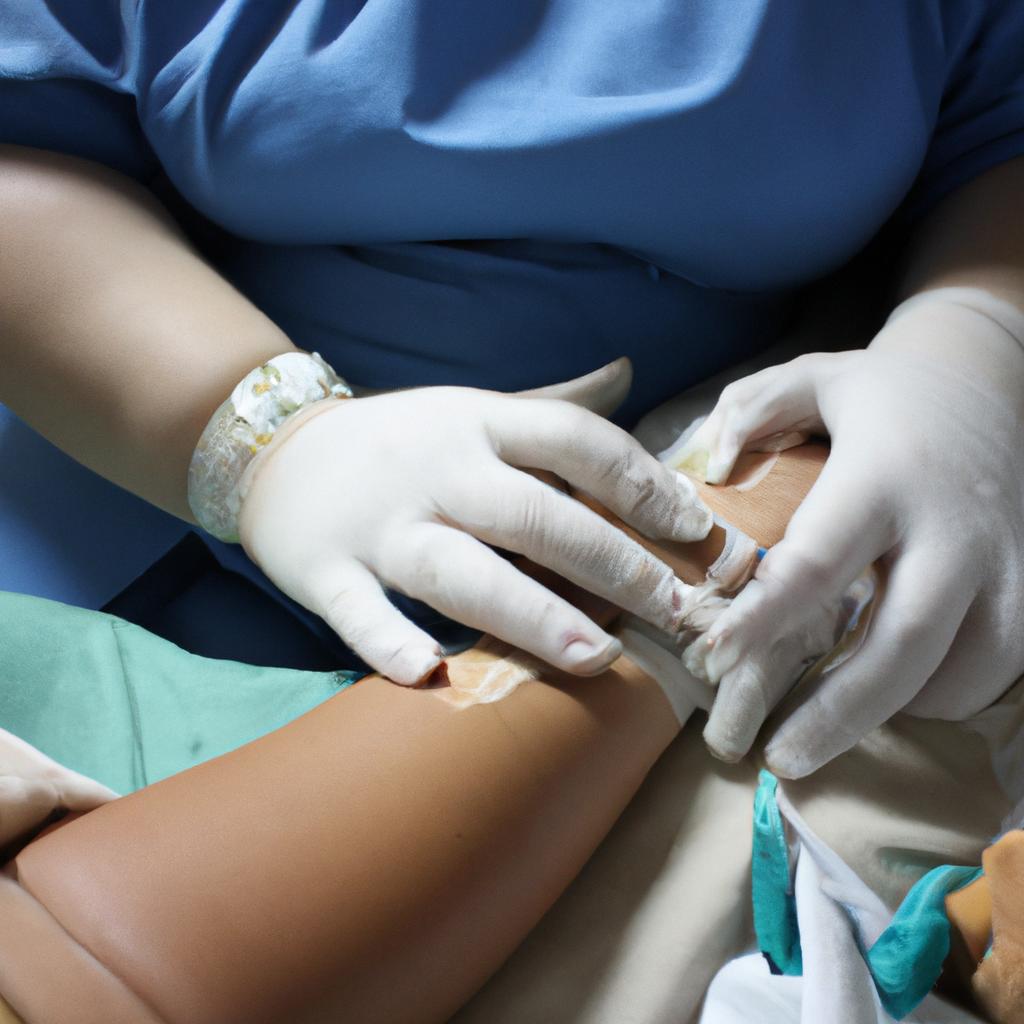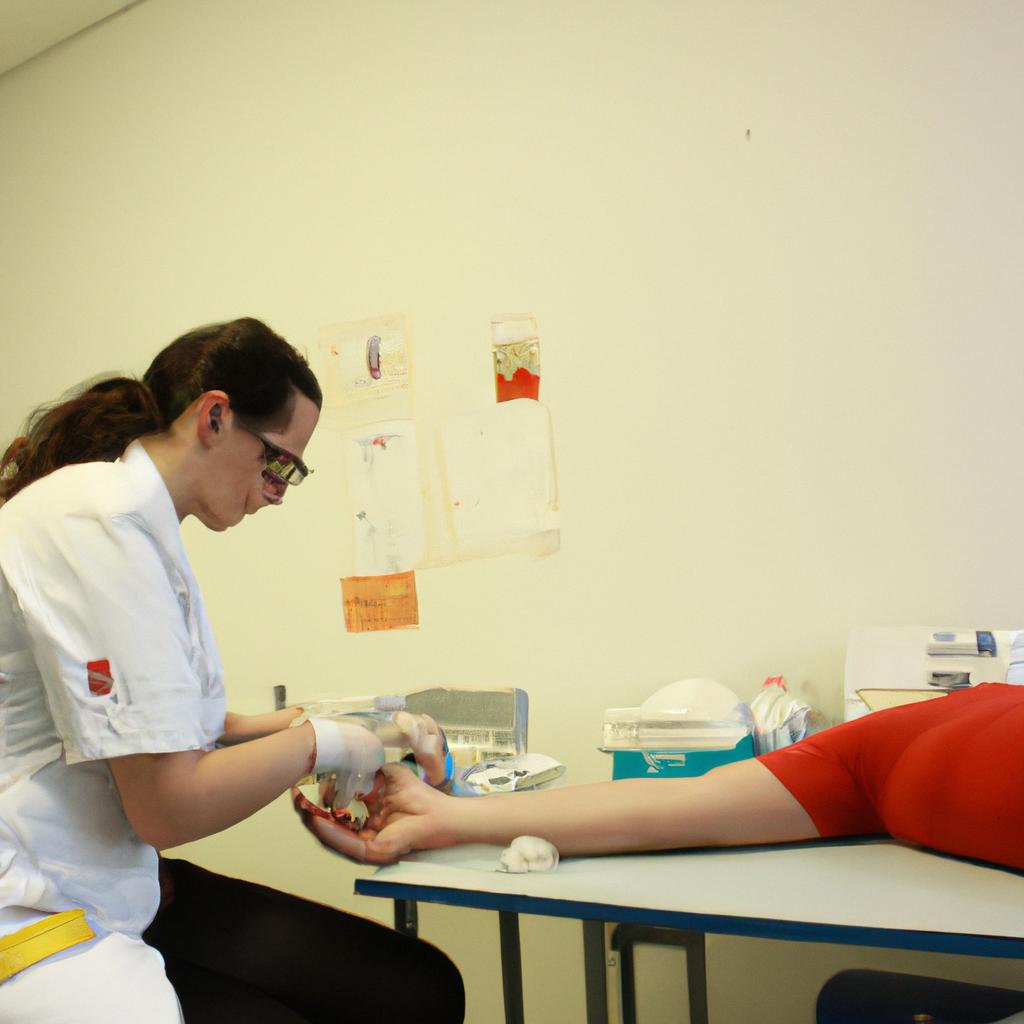Symptoms of Juvenile Myositis: An Informative Overview

Juvenile Myositis (JM) is a rare autoimmune disease that primarily affects children and adolescents, causing inflammation of the muscles and tissues. This debilitating condition can have profound effects on the physical well-being and overall quality of life for those diagnosed with it. Understanding the symptoms of JM is crucial in order to facilitate early diagnosis and prompt medical intervention. For instance, imagine a 10-year-old child named Sarah who experiences persistent muscle weakness, fatigue, and skin rashes. These indicators may initially be dismissed as signs of growing pains or mild allergies; however, they could potentially point towards an underlying case of Juvenile Myositis.
One primary symptom characteristic of Juvenile Myositis is muscle weakness, which often begins gradually and worsens over time. Affected individuals may struggle with activities such as climbing stairs, lifting objects, or even getting out of bed due to loss of strength in their muscles. In some cases, this weakness can become severe enough to impair mobility altogether, requiring assistance or aids like wheelchairs for daily functioning. Furthermore, another distinct symptom commonly observed in patients with JM is rash formation on the skin. These rashes typically present as reddish-purple patches known as heliotrope rash around the eyelids or Gottron’s papules on the knuckles, elbows, and knees. These rashes may be accompanied by skin sensitivity, itchiness, or even ulceration in severe cases.
In addition to muscle weakness and skin rashes, other possible symptoms of Juvenile Myositis can include fatigue, joint pain or swelling, difficulty swallowing or breathing due to weakened muscles in the throat or lungs, fever, and weight loss. It is important to note that not all individuals with JM will experience all of these symptoms, and the severity can vary from person to person.
If a child exhibits any combination of these symptoms for an extended period of time (typically more than several weeks), it is recommended to seek medical evaluation from a pediatrician or a specialist in rheumatology or dermatology. Diagnosis often involves a thorough physical examination, blood tests to check for specific antibodies associated with JM such as anti-Mi2 or anti-Jo1 antibodies, imaging studies like magnetic resonance imaging (MRI) or ultrasound to assess muscle inflammation, and sometimes even a muscle biopsy for confirmation.
Early diagnosis and treatment are crucial in managing Juvenile Myositis effectively. The goal of treatment is to suppress the immune system’s overactivity and reduce inflammation in the muscles and tissues. This typically involves medications such as corticosteroids (e.g., prednisone), immunosuppressants (e.g., methotrexate), biologics (e.g., rituximab), or other targeted therapies depending on the individual’s specific condition.
In addition to medication-based treatment approaches, physical therapy plays a significant role in helping patients maintain muscle strength and mobility. Occupational therapy may also be utilized to address difficulties with daily activities. Regular follow-up appointments with healthcare professionals are necessary to monitor disease activity and adjust treatment plans accordingly.
It is important for parents and caregivers to provide emotional support for children diagnosed with Juvenile Myositis as they navigate through challenges and potential limitations imposed by the condition. Connecting with support groups or organizations dedicated to Juvenile Myositis can also provide valuable resources, information, and a sense of community for affected individuals and their families.
Overall, while Juvenile Myositis poses significant challenges, early diagnosis, appropriate medical intervention, and ongoing supportive care can help improve outcomes and enhance the quality of life for those living with this rare autoimmune disease.
Overview of Juvenile Myositis
Imagine a young girl named Emily, who wakes up one morning with severe muscle weakness and fatigue. She struggles to get out of bed and experiences difficulty in lifting her arms or climbing stairs. Frightened by these sudden changes, Emily’s parents rush her to the hospital where she is diagnosed with juvenile myositis (JM). This autoimmune disease primarily affects children and adolescents, causing inflammation in their muscles.
Juvenile myositis encompasses a group of rare conditions characterized by chronic muscle inflammation. The exact cause of JM remains unknown; however, it is believed to involve both genetic predisposition and environmental triggers. Research suggests that certain viral infections may play a role in triggering this autoimmune response, leading to the characteristic symptoms experienced by affected individuals.
To better understand the impact of juvenile myositis on those affected, consider the following emotional responses:
- Fear: Parents often experience fear upon witnessing their child’s sudden decline in physical abilities.
- Frustration: Children with JM can become frustrated when they struggle to perform tasks they once found easy.
- Isolation: Due to limitations imposed by their condition, individuals with JM may feel isolated from their peers.
- Hopelessness: The relentless nature of juvenile myositis can lead to feelings of hopelessness for both patients and caregivers.
In addition to understanding the emotional toll that JM takes on individuals and families, it is important to recognize the wide range of symptoms associated with this condition. These symptoms can vary significantly from person to person but typically include muscle weakness, rash, joint pain, fever, and fatigue. To provide a clearer overview of the common signs exhibited by those with JM, refer to Table 1 below:
| Symptom | Description |
|---|---|
| Muscle Weakness | Difficulty in performing basic movements such as walking or grasping objects |
| Rash | Reddish or purplish patches on the skin, often found around the eyelids or elbows |
| Joint Pain | Aching and swelling in the joints, making movement painful |
| Fatigue | Persistent feeling of exhaustion, even after minimal physical exertion |
Understanding these symptoms is crucial for early detection and effective management of juvenile myositis. In the subsequent section, we will explore each symptom in detail to provide a comprehensive understanding of their presentation and impact.
Common Symptoms of Juvenile Myositis
Now that we have established an overview of juvenile myositis, let us delve into the common symptoms experienced by those affected.
Common Symptoms of Juvenile Myositis
Symptoms of Juvenile Myositis: An Informative Overview
Juvenile Myositis (JM) is a rare autoimmune disease that primarily affects children and adolescents. In this section, we will explore the common symptoms associated with JM. To provide context, let us consider an example involving a hypothetical case study.
Imagine a 10-year-old child named Emily who begins experiencing muscle weakness, fatigue, and skin rashes. Concerned about her condition, Emily’s parents take her to see a rheumatologist for evaluation. After careful examination and diagnostic tests, Emily is diagnosed with juvenile dermatomyositis (JDM), which is one subtype of JM.
The symptoms of JM can vary among individuals but generally involve muscle inflammation and damage. Here are some common signs indicating the presence of JM:
- Muscle weakness: Persistent weakness in the muscles often leads to difficulty in performing everyday tasks such as climbing stairs or lifting objects.
- Skin rashes: Many patients develop characteristic rashes on their face, knuckles, elbows, knees, or other parts of the body.
- Fatigue: Excessive tiredness and lack of energy may be experienced even after mild physical exertion.
- Joint pain: Some individuals with JM experience joint stiffness and pain that can limit their mobility.
These symptoms could significantly impact a child’s quality of life by affecting their ability to participate in school activities, sports, or social interactions. The emotional toll on both the affected child and their family cannot be underestimated.
| Emotional Impact |
|---|
| Feelings of frustration |
| Anxiety about long-term prognosis |
| Sense of helplessness |
| Social isolation |
Understanding these emotional aspects is vital for healthcare professionals working alongside patients with JM to provide comprehensive care and support.
In the subsequent section about “Muscle Weakness as a Symptom,” we will delve deeper into one of the hallmark symptoms of JM and discuss its implications for affected individuals.
Muscle Weakness as a Symptom
Symptoms of Juvenile Myositis: An Informative Overview
Common Symptoms of Juvenile Myositis can vary in severity and presentation, making early diagnosis a challenge. Understanding the range of symptoms associated with this condition is crucial for timely intervention and appropriate management. In this section, we will explore one prominent symptom of juvenile myositis – muscle weakness – which often serves as an initial indicator.
To illustrate the impact of muscle weakness in juvenile myositis, let’s consider the hypothetical case study involving Sarah, a 10-year-old girl diagnosed with dermatomyositis. Sarah began experiencing progressive muscle weakness, mainly affecting her proximal muscles such as those around her shoulders and hips. This resulted in difficulties climbing stairs, lifting objects, and even getting up from a sitting position without assistance.
Muscle Weakness:
- Gradual or sudden onset of weakness
- Difficulty performing daily activities that require strength (e.g., opening jars)
- Fatigue after minimal exertion
- Decreased stamina during physical activities
Sarah’s case highlights the debilitating nature of muscle weakness experienced by individuals with juvenile myositis. However, it is important to note that these symptoms can vary among patients. Some may experience mild weakness initially but progress to severe limitations over time.
Moreover, muscle weakness can significantly impact children’s overall quality of life and emotional well-being due to their inability to engage in regular activities enjoyed by their peers. It is essential for healthcare providers and caregivers to be aware not only of the physical implications but also the emotional toll on affected individuals.
Moving forward into our next section on “Skin Rash and Juvenile Myositis,” we will delve into another common symptom associated with this condition. By exploring each hallmark sign individually, we gain a comprehensive understanding necessary for accurate identification and subsequent treatment strategies.
Skin Rash and Juvenile Myositis
Skin Rash and Juvenile Myositis
In addition to muscle weakness, another common symptom of juvenile myositis is the presence of a skin rash. Let’s consider the case of Emily, a 10-year-old girl who started experiencing muscle weakness and fatigue. After several weeks, she developed a distinctive red rash on her face and knuckles. This combination of symptoms raised concerns about possible juvenile myositis.
-
Emotional Response Bullet Points:
- The appearance of an unexplained skin rash can be distressing for both children and their parents.
- Skin rashes in juvenile myositis often cause discomfort and itchiness, making it difficult for children to focus on daily activities.
- Parents may become worried and anxious when they notice these unusual changes in their child’s appearance.
- Understanding the link between skin rash and juvenile myositis can help alleviate some emotional stress associated with this condition.
To better understand the different types of rashes associated with juvenile myositis, let’s explore them through a table:
| Type of Rash | Description | Location |
|---|---|---|
| Gottron’s papules | Small, scaly patches that appear over bony prominences such as knuckles or elbows | Extensor surfaces |
| Heliotrope rash | A purplish-red discoloration around the eyes resembling sunglasses | Eyelids |
| Shawl sign | A flat or raised reddish-purple rash covering the upper back and shoulders like a shawl | Upper body |
| V-sign rash | A similar pattern to the shawl sign but localized around the neck area forming a “V” shape | Neck |
As shown above, there are distinct patterns of rashes associated with juvenile myositis. By recognizing these specific characteristics, healthcare professionals can make accurate diagnoses more efficiently.
Considering both muscle weakness and the presence of a skin rash, it becomes evident that juvenile myositis is a multifaceted condition affecting multiple systems in the body. This interconnectedness underscores the importance of timely and accurate diagnosis to prevent further complications.
Moving forward, let’s explore another set of symptoms often observed in children with juvenile myositis: gastrointestinal symptoms. Understanding these manifestations will provide us with a comprehensive understanding of this complex disease.
Gastrointestinal Symptoms in Juvenile Myositis
Gastrointestinal Symptoms in Juvenile Myositis
Imagine a young girl named Emily, who has been experiencing persistent abdominal pain and digestive issues over the past few months. At first, her parents dismissed it as common stomach troubles, but when the symptoms worsened and became more frequent, they decided to seek medical help. After several visits to different specialists and undergoing various tests, Emily was diagnosed with juvenile myositis (JM), an autoimmune disease that can affect multiple organs including the gastrointestinal system.
The gastrointestinal symptoms associated with juvenile myositis can vary widely from person to person. Some individuals may experience mild discomfort or occasional bouts of indigestion, while others may face more severe complications such as:
- Dysphagia: Difficulty swallowing is a common symptom seen in JM patients. It can lead to problems with eating and drinking, causing weight loss and malnutrition.
- Reflux: Gastroesophageal reflux disease (GERD) occurs when stomach acid flows back into the esophagus, causing heartburn and regurgitation. This condition can be particularly troublesome for children with JM due to weakened esophageal muscles.
- Abdominal Pain: Persistent cramping or sharp abdominal pain is frequently reported by those affected by JM. The intensity of the pain can range from mild discomfort to debilitating episodes that require hospitalization.
- Bowel Dysfunction: Children with JM may experience irregular bowel movements characterized by diarrhea or constipation. These disruptions in normal bowel function can further exacerbate their overall discomfort.
To gain a better understanding of how these gastrointestinal symptoms manifest in juvenile myositis patients, let’s take a closer look at some real-life cases through this table:
| Patient | Age | Gastrointestinal Symptom |
|---|---|---|
| Sarah | 8 | Dysphagia |
| Liam | 14 | Reflux |
| Ava | 11 | Abdominal Pain |
| Ethan | 9 | Bowel Dysfunction |
As seen in the table, each patient presented with varying gastrointestinal symptoms at different ages. This demonstrates the diverse ways juvenile myositis can affect individuals and highlights the importance of recognizing these signs early on for prompt medical intervention.
In addressing the impact of juvenile myositis on the gastrointestinal system, it becomes evident that this autoimmune disease can significantly disrupt a child’s overall well-being. By understanding and identifying these symptoms, healthcare providers can develop tailored treatment plans to alleviate discomfort and manage complications effectively.
Transitioning into our next section about respiratory symptoms in juvenile myositis patients…
Respiratory Symptoms and Juvenile Myositis
Moving on from the gastrointestinal symptoms associated with juvenile myositis, it is important to explore another area commonly affected by this condition — the respiratory system. By understanding the potential respiratory symptoms that can arise in individuals with juvenile myositis, we can gain further insight into the impact of this disease on overall health and well-being.
Respiratory Symptoms and Juvenile Myositis:
One example that illustrates the impact of juvenile myositis on a patient’s respiratory system is Emily, a 12-year-old girl diagnosed with dermatomyositis, a subtype of juvenile myositis. Despite initially experiencing muscle weakness and skin rashes, she later began exhibiting respiratory symptoms such as shortness of breath during physical activities and difficulty breathing while lying down. These manifestations were indicative of lung involvement due to her underlying condition.
- Persistent coughing or wheezing.
- Shortness of breath during exercise or daily activities.
- Chest pain or discomfort.
- Difficulty breathing while lying flat.
Furthermore, let us examine a table outlining additional respiratory symptoms frequently observed in patients with juvenile myositis:
| Symptom | Description |
|---|---|
| Interstitial lung disease | Lung tissue inflammation leading to scarring and impaired oxygen exchange. |
| Pleurisy | Inflammation of tissues surrounding the lungs causing sharp chest pain. |
| Aspiration pneumonia | Infection occurring when food, liquids, or saliva enter the lungs by mistake. |
| Pulmonary hypertension | High blood pressure within pulmonary arteries resulting in strain on heart. |
Understanding these respiratory symptoms is crucial in providing comprehensive care to individuals with juvenile myositis, as early detection and management can significantly improve their quality of life. It is important for healthcare providers to be vigilant and consider the possibility of lung involvement when evaluating patients presenting with muscle weakness or skin manifestations.
In summary, respiratory symptoms are a common manifestation of juvenile myositis, often causing discomfort and impairment in daily activities. By recognizing these symptoms promptly, medical professionals can implement appropriate interventions to alleviate distress and prevent further complications associated with this debilitating condition.






